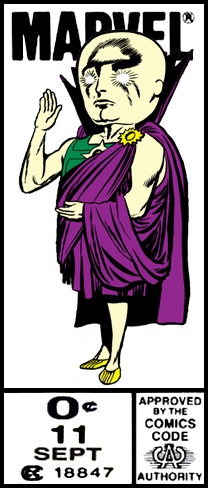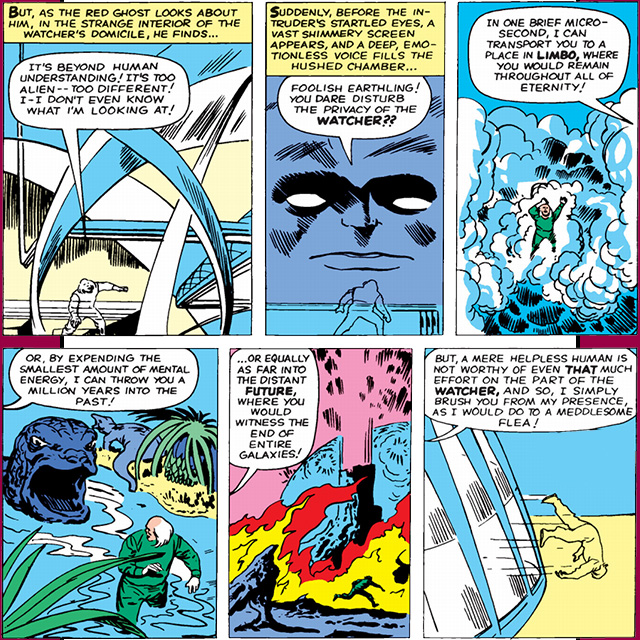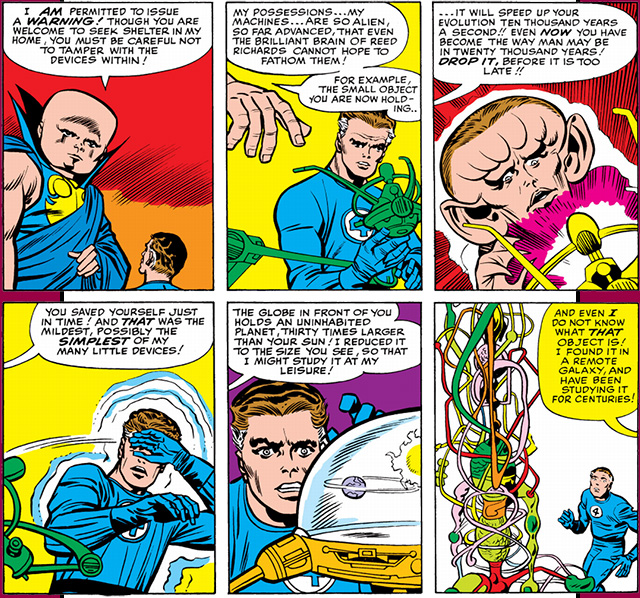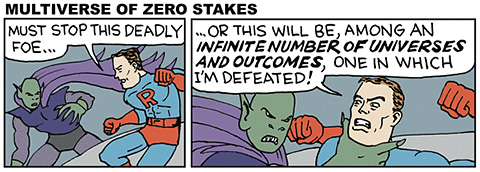

(season 1)
[Roy Thomas, Stan Lee, Jack Kirby,] Bryan Andrews, and Ashley Bradley, 2021
This is an animated anthology series. Virtually every character that has shown up in a Marvel Cinematic Universe film appears, all but a few of them voiced by their original actors. I didn’t want the credits above to be longer than the article, so I wasn’t about to list the creators of every single one of those characters, but I did want to credit the creator of the original What If? comic book series, which debuted in 1977. So I hopped on the internets to see what I could pull up about the development of the series, and was surprised to find that I came up empty. There were plenty of issue-by-issue guides, but nothing about how the series came to be—whose idea it was, how such an offbeat idea got approved, none of that. But I guess that must be that enshittification of search engines I’ve been hearing about lately, because it turned out that the answer was right there on the splash page of What If? #1: “Conceived, written, and edited by: Roy Thomas”. So I went looking specifically for interviews of Roy Thomas in which he discussed the origin of the What If? series, and that was a lot more productive.
In the 1960s, Roy Thomas was Marvel’s in-house continuity expert. Stan Lee cheerfully admitted in his editorial caption boxes that he couldn’t remember in which issue such-and-such a returning villain had previously appeared, but Roy always knew. He explained, “Comics continuity has been important to me since I was a kid. I found it hard to take seriously Superman and Batman stories in which the two would fight evil Martians in two different stories—and they’d be different races of Martians. If comics didn’t take their own stories seriously enough to remember them from one month to the next, why should I as a reader?” In 1972, when Stan stepped back from his thirty-year stint as Marvel’s editor to take on a less hands-on role as publisher, Roy Thomas took over the editor’s chair. It seemed only natural: if anyone could read a draft version of a script and instantly say, “Actually, this contradicts Tales to Astonish #44 from 1963!”, it was Roy. But after a couple of years, he was burnt out. It was one thing to burn the midnight oil figuring out how Venus #1 from 1948 fit with the Silver Age depictions of the Greek pantheon, purely out of personal interest. It was quite another to have to ride herd on a bunch of creative temperaments who didn’t want to hear that they couldn’t use Thor this month because issue #213 of his own book had him on the other side of the galaxy. So not only did Thomas hand the reins at Marvel over to Len Wein, but he focused on writing assignments that would allow him to work without having to coordinate with anyone. He did keep his gig writing Fantastic Four, but otherwise, his mid-’70s docket included several Conan the Barbarian books, set in their own separate continuity, and Invaders, set during World War II. The cover of What If? #1 billed the series as a service to readers—one that would feature “the stories your letters have demanded!!”. But it also fit in with Roy Thomas’s agenda nicely. He could revisit any comic that struck his fancy and spin out his own story without worrying about how it fit into the jigsaw puzzle of Marvel history—the whole point was that it didn’t fit, that it was, as every splash page proclaimed from #3 onward, “a stunning saga of an alternate reality” rather than the official Marvel Universe timeline.
But…
…in 1972, Marvel started up a subsidiary called Marvel UK to repackage its comics for British readers: replacing Americanisms, redrawing women to be “more decent”, and publishing weekly instead of monthly, with multiple features per magazine. That pace meant that, even with a decade of back issues to work through, the company would soon run out of material. And so Marvel UK started making up the difference by producing original material, starting with Captain Britain, which launched in 1976. And it was in a Captain Britain story for Marvel UK in 1983 that an up-and-coming writer named Alan Moore introduced the Captain Britain Corps, a superhero group consisting of different versions of the same character, each from a different universe. There was Captain England from Earth‑522, Captain Albion from Earth‑523, Captain Commonwealth from Earth‑920… and Captain Britain, Moore revealed, was not from Earth‑1, as readers might expect, but Earth‑616. I.e., the mainstream Marvel Universe was just one number out of many, nothing particularly special. It wasn’t long before the fans and creators realized the implications: that meant every issue of What If? took place in its own universe! What If? #1, “What If Spider-Man Joined the Fantastic Four?”—why, that was Earth‑772! What If? #2, “What If the Hulk Had the Brain of Bruce Banner?”—welcome to Earth‑774! Even issue #11, “What If the Original Marvel Bullpen Had Become the Fantastic Four?”, with Stan Lee as Mr. Fantastic and Jack Kirby as the Thing—that was a comedy issue, but it took place on Earth‑1228! There were enough of these, both in What If? and other books, that the numbers got pretty big. One of the few issues of What If? I bought as a kid was #38, because it promised a story about the Vision and the Scarlet Witch; that, it was later decided, had taken place on Earth‑83438. So did that mean that all these What If? stories were part of the Marvel Universe? No. But they were part of the Marvel Multiverse!
The idea that all these different variations on the MU were numbered like television stations put a new twist on What If?’s framing sequence, in which the Watcher explains that he spends much of his time looking into the “many windows into the strange parallel worlds of what might have been”. Wait, “the Watcher”? Who’s this guy? We first meet him in Fantastic Four #13, cover date 1963.04, in which the F.F. travel to “the mysterious blue area of the moon”, which turns out to have an artificially generated oxygen atmosphere. There the find the ruins of an ancient city, with one inhabited “ultra-modern house”—and, almost immediately, they get into a fight with a Ivan Kragoff, a.k.a. the Red Ghost, and his trio of super-apes. (Long story.) This fight is interrupted when a giant alien with glowing eyes and pale yellow skin, as seen in the corner box above, appears, explaining that “I come from a world so far from here that you do not even suspect its existence” and that “my people roam the entire known universe, watching, observing other worlds!” Kragoff decides to break into the Watcher’s home (“What a fabulous storehouse of scientific marvels it must be!! Once I learn the Watcher’s secrets, the universe itself will be mine!”), which turns out to be a mistake:










